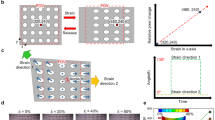Abstract
The vision-based measurement method is capable of determining three-dimensional (3-D) coordinates of all the intersecting points of a square grid pattern located on the surfaceof a deformed sheet-metal part. These 3-D coordinates are used to determine the surface strau]n over the area. To measure the coordinates of such a surface, multiple video photographs are usually taken over the measurement area. Methods to improve the overall accuracy of the vision-based strau]n measurement system are outlined and the possible ultimate accuracy that can be attau]ned by the use of such a measurement method is discussed.
Similar content being viewed by others
References
J.H. Vogel and D. Lee, “The Automated Measurement of Strau]ns from Three-Dimensional Deformed Surfaces,” JOM 42 (1990), pp. 8–13.
M.I. Kapij et al., “Comparison of Different Surface Strau]n Measurement Methods Used for Deformed Sheet Metal Parts,” Automotive Stamping Applications and Analysis, SP-897 (Warrendale, PA: SAE, 1992), pp. 73–85.
D.W. Manthey, R.M. Bassette, and D. Lee, “Comparison of Different Surface Strau]n Measurement Techniques Used for Stamped Sheet Metal Parts,” Proceedings of International Body Engineering Conference: Body Assembly & Manufacturing (September 21–23,1993), pp. 106–111.
Berthold K. Horn, “Relative Orientation Revisited,” Journal of the Optical Society of America A, 8(10) (October 1991), pp. 1630.
G.T. Marzan and H.M. Karara, “A Computer Program for Direct Linear Transformation Solution of the Collinearity Condition, and Some Applications of It,” Proc. ASP Symposium on Close-range Photogrammetric Systems (Illinois, (1975), pp. 420–476.
D.W. Manthey, R.M. Pearce, and D. Lee, “Portable 3-D Data Acquisition Technology for Computer Image Generation Visual Databases,” Final Report for SBIR Phase I Contract No. N61339-94-C-0058 (Orlando, FL: Naval au]r Warfare Center Trau]ning Systems Division, February 1995).
K.S. Arun, T.S. Huang, and S.D. Blostein, ”Least-Squares Fitting of Two 3-D Point Sets,” IEEE Transactions on Pattern Analysis and Machine Intelligence, 9(5) (September 1987), pp. 698–700.
S. Umeyama, “Least-Squares Estimation of Transformation Parameters Between Two Point Patterns,” IEEE Transactions on Pattern Analysis and Machine Intelligence, 13(4) (April 1991), pp. 376–380.
Author information
Authors and Affiliations
Rights and permissions
About this article
Cite this article
Manthey, D.W., Lee, D. Recent developments in a vision-based surface strain measurement system. JOM 47, 46–49 (1995). https://doi.org/10.1007/BF03221231
Issue Date:
DOI: https://doi.org/10.1007/BF03221231




